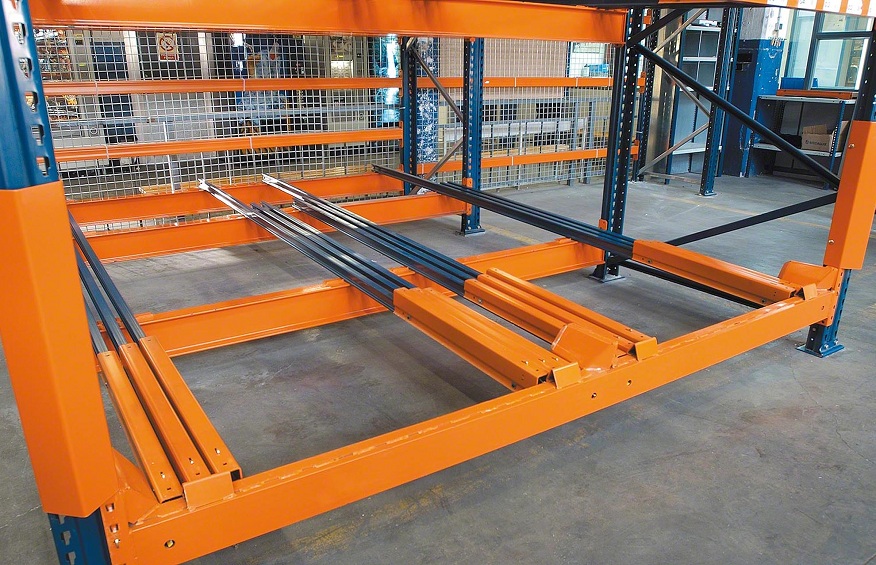10 Tips for Efficiently Using Push Back Pallet Racking
Push-back pallet racking is a dynamic warehouse storage solution designed to increase storage capacity while maintaining ease of access. As an essential part of many warehouse storage rack systems, understanding how to utilize push-back pallet racking efficiently can significantly enhance warehouse operations. This guide provides 10 tips for optimizing push-back pallet racking systems in your warehouse.
Understand the Push Back Racking System
Before implementing a pushback racking system, it’s crucial to understand how it works. Pushback racks consist of inclined rails and nested carts. When a pallet is loaded from the front, it pushes the pallet behind it back one position. This system allows pallets to be stored 2 to 5 deep, providing high-density storage. Understanding this system helps in planning how to utilize it for your specific needs best. It’s ideal for storing multiple pallets of the same SKU and offers a balance between selectivity and storage density, making it a versatile solution for many warehouses.
Properly Train Staff
Effective use of push-back pallet racking requires properly trained staff. Ensure that all warehouse personnel are trained in this system’s safe and efficient operation. Training should cover loading and unloading procedures, safety practices, and how to identify and report any issues with the racking system. Proper training minimizes the risk of accidents and product damage and ensures your team can efficiently handle the storage system.
Regularly Inspect and Maintain the Racking System
Regular inspection and maintenance are essential for the longevity and safe operation of push-back pallet racking systems. Schedule routine inspections to check for any signs of damage, wear, or misalignment. Pay special attention to the condition of rails, carts, and pallets. Any issues should be addressed promptly to prevent accidents and ensure smooth operation. Regular maintenance helps maintain the racking system’s structural integrity and prolongs its lifespan.
Optimize Your Warehouse Layout
Maximize the efficiency of push-back pallet racking by optimizing your warehouse layout. Place racks in a configuration that complements your operational flow. Consider factors such as the frequency of pallet access, the type of goods stored, and the movement of loading and unloading equipment. An efficient layout reduces travel time, improves accessibility, and enhances warehouse productivity.
Use Quality Pallets
The efficiency of push-back pallet racking systems greatly depends on the quality of the pallets used. Ensure that pallets are sturdy, uniform in size, and good condition. Damaged or poor-quality pallets can cause jams in the racking system, leading to operational delays and potential safety hazards. Using high-quality pallets ensures smooth operation and reduces the risk of product damage and racking system damage.
Implement Load Management Practices
Effectively manage the load within your push-back racking system. Understand the weight capacity of your system and ensure it is not exceeded. Distribute weight evenly across the racks to maintain stability. Proper load management prevents overloading, which can cause structural damage and pose safety risks.
Organize Inventory for Accessibility
Organize your inventory strategically within the pushback racks. Store frequently accessed items in more accessible positions. Group similar items together to streamline picking processes. A well-organized push-back racking system enhances efficiency by reducing the time and effort needed to locate and retrieve items.
Monitor Inventory Turnover
Keep track of inventory turnover to ensure that items stored in push-back racks are not becoming stagnant. High-density storage solutions like pushback racking can sometimes lead to older stock being overlooked. Regularly monitoring turnover helps implement a first-in, first-out (FIFO) or last-in, first-out (LIFO) inventory management strategy, depending on the nature of your products. This practice is crucial in managing inventory effectively and reducing the risk of obsolescence.
Utilize Warehouse Management Systems
Integrate your push-back pallet racking system with a warehouse management system (WMS) to enhance efficiency. A WMS provides real-time data on inventory levels, locations, and movements. This integration enables better tracking, reduces errors, and streamlines operations. The use of technology in warehouse management significantly contributes to the overall effectiveness of your storage solutions.
Partner with a Storage Solutions Expert
Consider partnering with a storage solutions expert to optimize push-back pallet racking systems. Companies like Camara Industries offer expertise in warehouse storage solutions, providing guidance on the best practices for using push-back racking systems. Their experience and knowledge can help you maximize storage efficiency and operational effectiveness.
Conclusion
Efficiently utilizing push-back pallet racking systems can transform your warehouse operations, offering high-density storage while maintaining ease of access. Following these tips can optimize your storage practices, enhance safety, and improve overall efficiency. For expert advice and a range of quality storage solutions, including push-back pallet racking, visit Camara Industries’ website. Discover how their expertise can elevate your warehouse storage capabilities and streamline operations.

